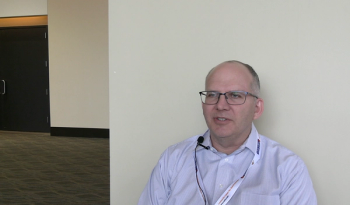
Integration of a Bifunctional Quantum Cascade Laser with Detection for Lab-on-a-Chip Mid-Infrared Absorption Spectroscopy
We recently interviewed Benedikt Schwarz, Ph.D., a principal investigator at TU Wien, in Vienna, Austria, about his work in the integration of a bi-functional quantum cascade laser with detection capabilities for lab-on-a-chip mid-IR absorption spectroscopy. Schwarz won a FACSS Innovation award at the 2018 SciX conference for this work, and this interview is part of a series of interviews with the winners of awards presented at SciX.
Mid-infrared spectroscopy is one of the key analytical techniques used for chemical sensing of organic compounds for myriad applications, including forensic detection, environmental monitoring, and medical diagnosis. The typical mid-infrared spectrometer consists of a broadband thermal emitter as the source combined with a broadband detector. The source and detector are matched with a Fourier-transform infrared (FT-IR) interferometer and external transfer optics for sampling; these components comprise the complete benchtop spectrometer. There is an increasing demand for more compact and cost-effective sensing solutions to replace bulky laboratory systems. Such portable infrared devices ideally incorporate all necessary optical components and functionality onto a single chip. A key development to realize such monolithically integrated spectrometers is the integration of a bi-functional quantum cascade laser with detection capabilities. We recently interviewed Benedikt Schwarz, PhD, a principal investigator at TU Wien, in Vienna, Austria, about his work in this field. Schwarz won a FACSS Innovation award at the 2018 SciX conference for this work, and this interview is part of a series of interviews with the winners of awards presented at SciX.
One of your most cited papers to date (1) discusses the integration of a bifunctional quantum cascade laser with detection capabilities. This work represents a novel, monolithically integrated sensor for mid-infrared absorption spectroscopy. What prompted you to investigate this problem?
The initial idea goes back to the beginning of my Ph.D. in 2011. While my main interest was initially theory and modeling, I was looking for a topic that had the potential to achieve a real impact for practical applications. Since then I have been working on the challenging goal to build on-chip integrated mid-infrared sensors and spectrometers.
How is what you have done different from what others have done previously?
Many other researchers focus on the integration of mid-infrared photonics on the silicon platform. One of the key benefits of silicon is its natural oxide that led to the famous complementary metal-oxide-semiconductor (CMOS) process. In photonics, the silicon platform is mainly limited by the technological challenge to integrate active optical components such as lasers and detectors. Nevertheless, silicon is often used for telecom wavelengths due to its excellent waveguiding properties and low-cost of fabrication. In the mid-infrared, silicon photonics loses nearly all of its attraction (or appeal), as the natural oxide is absorbing over a wide spectral range.
We decided to follow a different strategy. We used the best available laser technology and extended it step-by-step to include both detectors and waveguides that are integrated and matched to the laser system.
Your device switches between laser and detector operation. You have chosen to create a device that interacts with the sample via a dielectric-loaded surface plasmon polariton (SPP) waveguide. What are the advantages of this approach to sampling for absorption spectroscopy?
The idea is to bring the sensor to the sample instead of the sample to the sensor. As an example, the dielectric-loaded surface plasmon polariton waveguides can be combined with microfluidics to detect the sample in place. An in situ monitoring system can give feedback for real-time process optimization even with small sample volumes. This in situ sampling approach is currently being brought to the next level in a new research project at TU Wien together with the chemistry department.
In your referenced paper (1) you describe the capability to reach parts per million (ppm) accuracy over a wide range of concentrations (0–60%). Have you been able to demonstrate such accuracy in a real-world application? What are your thoughts on the practicality of this sensor design for routine analysis of infrared absorbing molecules at the ppm concentration level?
Extending our sensors with microfluidics will enable us to probe the chips in a more controlled way and to implement them into real-world applications. In particular, we are targeting the detection of the secondary structure of proteins. I would also like to note that the presented sensor chips were based on the first generation of the bifunctional material and a major performance improvement was achieved during the last few years (3).
We also learned that the integration of all optical components is an advantage in terms of sensitivity. The lasers remain unchanged, the on-chip waveguides are much more efficient compared to free-space optics, and the on-chip detectors have an exceptionally low noise due to their small size. The main remaining challenge is most probably the contamination of the sensor. Given these improvements we will have the capability of low concentration detection.
You have described an elegant solution to the sampling or coupling issue using a surface plasmon polariton (SPP) waveguide. Using this waveguide, the electromagnetic wave propagates along a metal–dielectric interface demonstrating an evanescent wave decay on both sides (2,3). Would you describe this wave interaction phenomenon for our readers?
Traditional dielectric waveguides, such as optical fibers, are composed of two or more different dielectric materials. Metals show a fundamentally different optical behavior compared to dielectrics. The “free” electrons make them highly conductive and they appear shiny. A surface plasmon polariton can propagate along the interface between a dielectric and a metal. Their occurrence is a natural consequence of light propagation governed by Maxwell’s equations and their name originates from the coupling of photons and electrons in a quasi-particle picture. The loss in the metal is thereby crucial for its functionality. Hence, surface plasmon polaritons will always demonstrate a certain amount of absorption due to the damped oscillation of the electrons.
For us surface plasmon polariton waveguides have two key features: First, nearly all of the light propagates outside of the metal and can interact with the analyte and second, they can be easily integrated together with our lasers and detectors on the same chip. A drawback is the optical signal losses due to the metal. Although for liquid sensing the metallic signal absorption losses are much smaller compared to the absorption signal of the analyte, alternative concepts will be required when aiming for on-chip gas detection due to the smaller analyte signal of gases, as they are strongly diluted compared to liquids
What were some of the key challenges you encountered during the development of this device?
Mostly, it was the overall complexity due to the many different aspects that have to be considered, such as the performance of all elements, electrical crosstalk, the compatibility to standard III–V fabrication lines, and other complications. In the beginning we mainly focused on the detector performance. Later we found that the laser performance is much more important. It took us a while to find the right strategy to optimize the laser and detector materials. In 2017 during my research visit at Harvard University we achieved the final breakthrough and showed that the added detector functionality has virtually no drawbacks (3). With this breakthrough, high power and continuous wave operation of the laser are no longer an issue.
What would you consider to be the most useful contribution of your work?
I believe it is the principal strategy to directly integrate all optical components on the III–V semiconductor platform. Building good lasers is the most difficult part in the mid-infrared technology. Hence, it always seemed logical to me to use the best available laser technology and to rather take a compromise on the other optical components.
What are your next steps in this work?
About a year ago, I started with a small research team to target the remaining technical challenges for multi-species analysis. The main question is: How can we efficiently integrate a mid-infrared spectrometer on a single chip? Currently, we are focusing on dual-comb spectroscopy. I am convinced that it is the ideal technique for miniaturization and it is compatible with our previous efforts. However, it does not come for free. Quantum cascade laser frequency combs are very sensitive and advanced stabilization techniques are required. In our recent work, we showed that by coherent electrical injection locking we can make them much more robust against harsh real-world conditions (4). Our findings enable the downscaling of dual-comb spectroscopy to very small footprints. Now, we are working on the on-chip integration of dual-comb spectroscopy and the reduction of the power consumption to target mobile hand-held devices. Our newest unpublished proof-of-principle demonstration is already very promising and as soon as all technical challenges are solved, the real-world applications will be in reach.
References
(1) B. Schwarz, P. Reininger, D. RistaniÄ, H. Detz, A.M. Andrews, W. Schrenk, and G. Strasser, Nat. Commun.5, 4085 (2014).
(2) S.A. Maier, Plasmonics: Fundamentals and Applications (Springer Science & Business Media, May 16, 2007).
(3) B. Schwarz, C. A. Wang, L. Missaggia, T. S. Mansuripur, P. Chevalier, M. K. Connors, D. McNulty, J. Cederberg, G. Strasser, and F. Capasso, ACS Photonics4, 1225 (2017).
(4) J. Hillbrand, A. M. Andrews, H. Detz, G. Strasser, B. Schwarz, Nat. Photonics Dec 10:1 (2018)
Benedikt Schwarz is a visiting postdoctoral researcher at Harvard University, School of Engineering and Applied Sciences with Prof. Federico Capasso. He is also a principal investigator at Technical University Wien, Vienna, Austria, Institute of Solid State Electronics. He completed his Ph.D. in technical Sciences, at TU Wien with a thesis on monolithic integration of mid-infrared photonics with Prof. Gottfried Strasser. Currently, he is building up his own research team at TU Wien focusing on the on-chip integration of mid-infrared spectrometers using frequency combs.
Newsletter
Get essential updates on the latest spectroscopy technologies, regulatory standards, and best practices—subscribe today to Spectroscopy.




